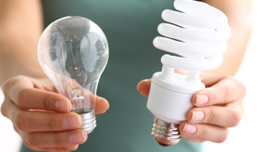Our Initiatives
Reduce

The most obvious and immediate way to conserve resources is simply to use fewer. The House is working toward a more efficient business model through efforts ranging from composting food waste to consolidating computer servers.
-
CFL Bulb Replacements
We installed more than 13,000 compact fluorescent light bulbs (CFLs) across the House campus, saving nearly 1.5 million kWh and $163,000 annually. Each CFL accounts for $12.50 in annual energy savings and pays for itself within a few months.
-
Food Service Greening
We replaced all Styrofoam and plastic takeout containers with biodegradable alternatives. We compost hundreds of tons of food waste material every year. We now serve locally-sourced and / or organic food.
-
Water Conservation
We have projects underway to reduce water consumption by an estimated 32%. We are replacing inefficient toilets and faucets with low-flow models, and exploring options for substantially reducing irrigation water use.
-
Heating and Cooling Upgrades
We have made comprehensive efforts to eliminate leaks, seal ventilation ducts, and increase system efficiency. The Architect of the Capitol is aggressively implementing these upgrades.
-
Capitol Dome Relighting
We plan to illuminate the Capitol dome with 70 percent more efficient lighting. The new lights will also enhance the aesthetics of the dome.
-
LED Lights in the House Chamber
We will replace the House Chamber's television lighting with a vastly more energy-efficient light-emitting diode system.
-
Computer Server Consolidation
We are working to consolidate all 441 member office servers to improve energy efficiency and information security. Once implemented House-wide, consolidation and recent data center renovations will cut energy costs by more than $1 million annually. At full capacity, server consolidation could reduce the House's computing energy bill by more than 80 percent and save several million dollars annually.
-
Fuel Switch: Coal to Natural Gas
We converted the Capitol Power Plant from coal to natural gas. The switch reduced annual greenhouse gas emissions by more than 10,000 metric tons of CO2 equivalent (CO2e). The CPP is no longer the largest carbon emitter in Washington, D.C.
-
A Green Fleet
We have purchased more than 40 electric and hybrid vehicles for the House fleet, including a hybrid diesel truck for longer distance hauling. Biodiesel shuttles provide employee transportation on campus and to Union Station.
-
Night Lighting Policy
We implemented a House-wide policy to turn off unnecessary lights on nights and weekends. Potential savings amount to hundreds of thousands of dollars annually.
-
Energy Savings Performance Contract
We entered into a public / private partnership with an energy service company to implement a range of major energy and water saving measures, including energy-efficient lighting upgrades, HVAC and controls upgrades, water conservation upgrades and steam trap replacements that are anticipated to save the House more than $3.3 million annually.
-
Energy-Efficient Window Upgrades
We are reducing weather impact on cooling systems by installing solar-reflective window film, replacing inefficient windows and installing solar shades in all House office buildings.
-
Paper Reduction
We are working to reduce House paper consumption by half. So far, the House has reduced its paper consumption by nearly 176 tons annually, saving $240,000 every year. Measures include switching paper publications to online formats and using paperless electronic faxing. Electronic faxing alone saves the equivalent of 1,500 trees and 350,000 pounds of greenhouse gasses annually. Eliminating cover sheets from mail deliveries has saved more than three tons of paper per year.
-
Wind-Sourced Electricity
The House now purchases renewable wind energy to counterbalance the carbon emissions of its electricity consumption.
-
Smart Power Strips
We have installed more than 3,000 energy-saving power strips called Smart Strips. Smart Strips are designed to turn off computer peripherals when not in use. Smart Strips and power management settings are installed in the offices of all incoming freshmen Members. When installed House-wide, Smart Strips are expected to create almost $200,000 in energy savings.
-
Capitol Visitor Center
The Capitol Visitor Center composts food waste, uses china service ware in the cafeteria, and uses natural light and occupancy sensors to minimize electricity use. Waste from the center's construction was recycled, and 85 trees were planted to replace those lost during construction.
-
Energy Consumption
Over the past three years, the House has reduced energy consumption significantly. We have implemented programs and actions to meet Green the Capitol's goal of a 50-percent reduction over a 10-year period ending in 2017.Working with our Legislative Branch partners, we have launched energy-savings initiatives, like ENERGY STAR-compliant renovations of vending machine, sophisticated computer power management settings and a series of lighting modernizations that will result in $3.3 million of annual savings.